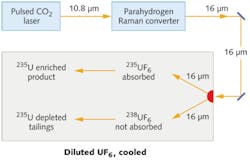SILEX laser uranium enrichment technology may create new nuclear-proliferation risks

The newest laser-based uranium-enrichment technology may provide a hard-to-detect pathway to nuclear-weapons production, according to Ryan Snyder, a physicist with the Princeton University (Princeton, NJ) Program on Science and Global Security.1
One example of this new third-generation laser enrichment technique may be the SILEX (separation of isotopes by laser excitation) process that was originally developed in Australia and licensed in 2012 for commercial-scale deployment in the United States to the Global Laser Enrichment consortium led by General Electric-Hitachi. Research on the relevant laser systems is also currently ongoing in Russia, India, and China.
Snyder's paper in Science & Global Security explains the basic physics of the new uranium-separation concept, which relies on the selective laser excitation and condensation repression of uranium-235 in a gas. It also estimates the key laser performance requirements and possible operating parameters for a single enrichment unit and how a cascade of such units could be arranged into an enrichment plant able to produce weapons-grade highly enriched uranium.
The process
Natural uranium (U) consists of a mix of isotopes, with the fissile isotope U-235 comprising a bit less than 1% and almost all the rest consisting of the nonfissile U-238. To separate out the useful U-235 using SILEX, uranium hexafluoride (UF6) is subjected to light at a wavelength of about 16 µm (which can be generated by Raman-scattering CO2 laser light), which excites a vibrational mode in the U-235 form of UF6 in a gas jet, allowing partial separation of the U-235 hexafluoride. The process is repeated to achieve increasing levels of purity.
Using plausible assumptions, Snyder's paper shows how a covert laser enrichment plant sized to make one bomb's worth of weapons-grade material a year could use less space and energy than a similar-scale plant based on almost all current centrifuge designs, the most-efficient enrichment technology in use today.
Uranium enrichment lab area of only 300 m2 neededFor example, the SILEX separation units themselves are 1 m long; the area footprint of a lab using a number of these units to produce 32.5 kg of highly enriched uranium is only 15 m x 20 m. These results suggest a direct impact on detection methods that use size or energy use as plant footprints.
Acquiring the key laser systems appears to be the main technological hurdle to states mastering this new enrichment process. The paper details some of the different lasers that, in principle, could be used for uranium enrichment. Technology-export controls on possible laser systems may be hard to implement since some of the lasers have multiple applications in areas such as medicine, telecommunications, and defense. One consequence of this is that commonplace laser research and development activities could allow more countries a latent nuclear weapons capability.
Snyder observes that an unexpected window of opportunity to think more carefully about the proliferation potential of the new laser technology has opened up with the April 2016 decision by General Electric-Hitachi to withdraw from the Global Laser Enrichment consortium, which has stalled the commercialization effort.
"We have a second chance to think about the risks of deploying new laser-based uranium enrichment technologies on a laboratory or industrial scale," says Snyder. "Previously developed technologies that provided pathways to nuclear weapons such as gaseous diffusion and gas centrifuges have spread to other countries, and the same should be expected with laser enrichment if commercial deployment of this new technology is successfully demonstrated."
The paper concludes with the suggestion that attention should be focused on regulating laser systems capable of enriching uranium to weapons-grade levels, otherwise such lasers may come to pose proliferation concerns comparable to if not greater than gas centrifuge development or plutonium reprocessing today.
Source: http://www.eurekalert.org/pub_releases/2016-06/puww-lue062716.php
REFERENCE:
1. Ryan Snyder, "A Proliferation Assessment of Third Generation Laser Uranium Enrichment Technology," Science & Global Security, Published online 23 Jun 2016; http://dx.doi.org/10.1080/08929882.2016.1184528

John Wallace | Senior Technical Editor (1998-2022)
John Wallace was with Laser Focus World for nearly 25 years, retiring in late June 2022. He obtained a bachelor's degree in mechanical engineering and physics at Rutgers University and a master's in optical engineering at the University of Rochester. Before becoming an editor, John worked as an engineer at RCA, Exxon, Eastman Kodak, and GCA Corporation.